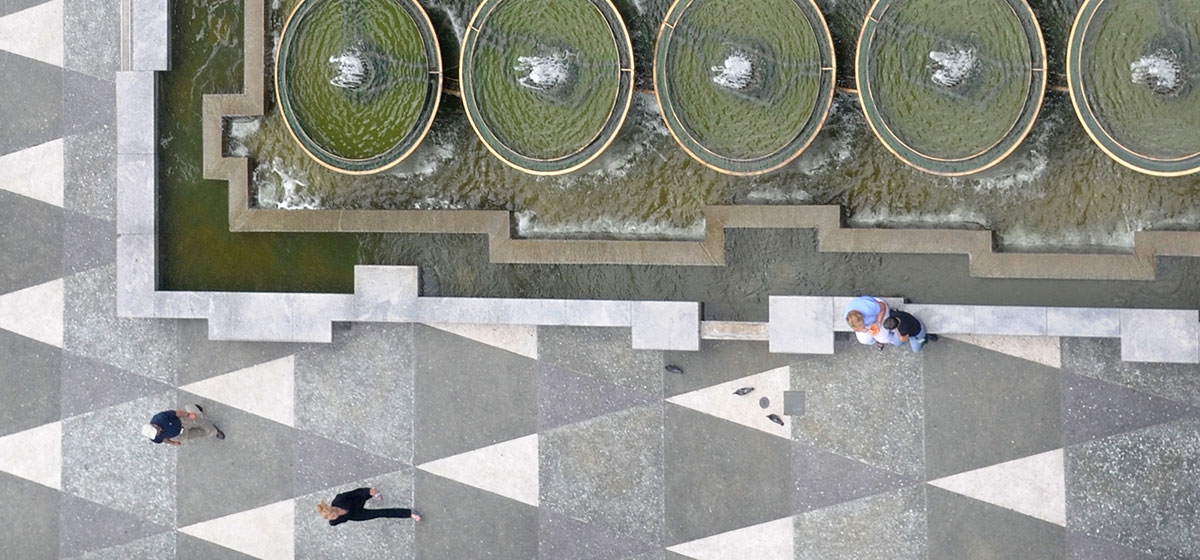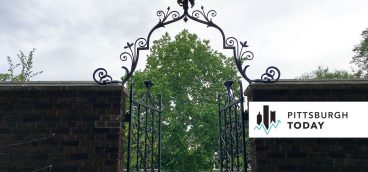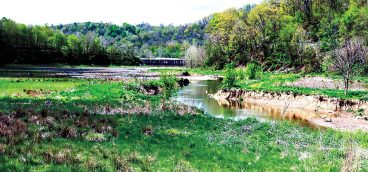
At noontime on a summer’s friday, Mellon Square—the green public space that lashes together so many of Downtown Pittsburgh’s office buildings, hotels, and businesses—is bustling. Ties loosen, heels are exchanged for sneakers and brown bags and sidewalk-stand hot dogs come out as office workers begin the brisk business of a respite from the cubicle by sitting under a tree or by the flowing fountain.
To Susan Rademacher, however, it’s not just the calm of a stroll through the square that’s enthralling, but the paving patterns under her feet. And while others enjoy the relaxation of a tree-side bench, she’s just as soothed by the curve of the supports that hold it up. Because, as parks curator at the Pittsburgh Parks Conservancy—the non-profit organization established to help the city restore and maintain its historic parks—Rademacher sees Mellon Square as more than just an urban oasis. She believes Mellon Square to be a historic masterpiece of modernist design, and she’s far from alone.
Completed in 1955 as a part of Pittsburgh’s first renaissance, Mellon Square served purposes both base and lofty: at once a parking lot and sanctuary; a public meeting space as well as an opening salvo in the war against Pittsburgh’s image of smog and smoke. In the intervening half-century, the square’s fortunes have risen and fallen just like the city surrounding it. Without financing for upkeep, its flora, lighting, and once-vibrant colors have fallen prey to ill maintenance. Meanwhile, changes to the design—made out of necessity due to Mellon Square’s ahead-of-its-time green roof concept—can now be retro-fitted with technology that has caught up to the artistic intent.
Mellon Square has played an important part in each of Pittsburgh’s renaissance movements—from its 1950s creation to its 1980s redevelopment. Now, as Pittsburgh’s reputation once again plays catch-up with its lush, green cityscape, the Pittsburgh Parks Conservancy is determined to bring Mellon Square back to its original glory and to honor it as the masterwork of modernism that it is—both as a gesture towards the new renaissance and as part of a new direction for the Conservancy itself.
In late-1940s Pittsburgh, trouble was brewing and Richard King Mellon knew it. The tycoon and civic leader had seen executive after executive refuse top positions at his Pittsburgh-based businesses, despite lucrative offers, because of their refusal to move to a dark, polluted, industrial city. And attracting new people and businesses to the city was far from Pittsburgh’s only problem. “Mellon and Mayor David Lawrence were thinking hard about how to reposition Pittsburgh after the war,” says Rademacher. “How to attract people and jobs and also how to retain companies—there was a significant threat at that time that Alcoa was going to relocate.”
The moment was ripe for a new Pittsburgh, as the optimism running rampant after the World War II heralded a new age in urban redevelopment across America. It was the era that engendered Point State Park, the Pittsburgh International Airport and the establishment of the Allegheny Conference on Community Development. Richard King Mellon himself had been quietly absorbing ideas on his travels and had one in particular that might help keep Alcoa in town.
“Mellon loved Rockefeller Center in New York—the concept of a large skyscraper and public plaza and the kind of vibrant public life that goes on between those two places,” says Rademacher. “He decided to build a new headquarters building for himself and, along with Mayor Lawrence, to appeal to Alcoa to remain in Pittsburgh with a new building adjacent to a grand civic space: two corporate skyscrapers anchored by this civic platform that could form a vibrant new center downtown.”
In 1949, with $4 million in funding secured through gifts from the three Mellon foundations, the City of Pittsburgh began buying up the largely disused Downtown land surrounded by the William Penn Hotel, Oliver Building and then-proposed sites for Alcoa and Mellon skyscrapers.
The plan, as stipulated in the Mellons’ grants, was for a 1,000-space parking garage topped by an outdoor green space “for an exclusively public purpose.” Inspired by San Francisco’s Union Square Garage, which had been built a decade earlier underneath the city’s central park, Mellon Square would be the world’s first purpose-built garage topped by a city park—and, in a way, Pittsburgh’s first “green roof.”
To make this vague and ambitious plan a reality, the city engaged the services of landscape architect John O. Simonds and architect Dahlen Ritchey, whose firm was also involved in the Mellon and Alcoa building designs. The team landed upon the Mellon Square that we can largely still see today after a host of changing and abandoned ideas, ranging from the sublime to the bizarre. “There were lots of different iterations, including a display of live sea lions or penguins, even a polar bear, in the square,” says Rademacher. “Cooler heads prevailed, and those stayed at the zoo. But the idea of an oasis, a cool refreshing body of water to anchor the square, remained key.
“Simonds [insisted] that it should be a platform. You have a huge change in grade from the William Penn Hotel to Smithfield Street. The platform creates a common space—a common floor—that knits all these buildings together.”
The result of the collaboration is a park that acts as a showcase of modernist landscape design. The simple geometries—from the trees and shrubs to the tiles that make up its flooring—combine to build a central square that simultaneously shelters visitors from the busy city streets and accentuates the architecture surrounding them. To Charles Birnbaum, founder and president of the Washington, D.C.-based Cultural Landscape Foundation, Simonds’s Mellon Square is historically and artistically important. As a parking garage/park, it combines urban renewal and modernist artistry. It’s also a masterwork by Simonds, who later made his mark with work from the Aviary and Allegheny Commons, to important landscapes from Chicago to Florida, as well a his still-classic landscape architecture textbook.
Just as important, Birnbaum says, is the investment Mellon Park has received despite its modernist appearance—as opposed to the smoother, more pastoral, and more readily accepted standards of Frick or Schenley parks.
“Simonds did so much for the city, and touched so many lives—his name has enormous cachet in Pittsburgh,” says Birnbaum. “It’s very interesting to me when a designer has that. Mellon Square is a space that’s been historically loved by Pittsburghers—in the ’50s, the ’80s, and today.”
In 2008, Birnbaum visited Pittsburgh to speak about Mellon Square and John Simonds to the Pittsburgh Parks Conservancy, and made a rather influential proposition. He feels strongly that Mellon Square should be given the rarified designation of National Historic Landmark—of which the National Park Service has named only around 2,600 sites of any type, including just five in the city of Pittsburgh.
“Birnbaum thought that Mellon Square, once restored, would be very worthy of joining that list,” says Meg Cheever, president and CEO of the Pittsburgh Parks Conservancy. “But apart from its historic design significance, just as a piece of open space, it seems like a really sound economic idea to restore it. [Downtown] is an area in transition in our city, and it’s really important that the park is a draw.”
The Mellon Square restoration represents another change in direction for an organization that’s become used to adaptation. Established in 1996, the Pittsburgh Parks Conservancy was initially planned as a “Schenley Park Conservancy”—a nonprofit modeled on New York City’s Central Park Conservancy, with just one park as its restoration target. But in order to work with the administration of then-Mayor Tom Murphy, the young organization quickly had to change tack and take on all four parks deemed regional assets (Schenley, Frick, Highland, and Riverview). Despite initial trepidation, the change proved fruitful for the city, its parks and the conservancy as well.
“In retrospect, it was probably a very good turn of events,” says Cheever. “We now have some very special parks expertise on staff, and you really can’t justify that unless you have a fairly sizeable operation. Working on multiple parks allows us to leverage these assets into every project we’re working on.”
In its 13 years, the conservancy has raised and spent over $40 million on projects in the parks, including its renovation of the Schenley Park Visitor’s Center and creation of Schenley Plaza in Oakland. Now, under the administration of Mayor Luke Ravenstahl, the conservancy’s purview has broadened again, this time to include all 171 parks in the City of Pittsburgh.
According to Cheever, near-future plans include a restoration of the walled garden in Shadyside’s Mellon Park and a joint venture with the Hill District organization Find The Rivers! to rehabilitate park land just blocks from the historic August Wilson house. The first job the conservancy will undertake, however, is Mellon Square—at the heart of Pittsburgh’s oldest area, and yet newest “neighborhood”: Downtown.
“In some ways, Mellon Square has more in common with Schenley Plaza than the other parks—it’s an urban area with a high-density population and a lot of daily foot traffic,” says Rademacher. “It also tells a story about Pittsburgh at a certain point in time and captures the design ethos of an era. So it fits right into what we do in terms of valuing the cultural landscape and understanding how to keep the history, maintenance and use in balance.”
“What’s different is that Downtown is emerging as a neighborhood. There are people living Downtown in greater numbers, and there’s a real desire to keep that growth going. And those people need outdoor spaces. That’s one of the functions of a park—the social fabric. Mellon Square can serve that function for Downtown.”
The changes that Pittsburghers will see in Mellon Square won’t seem dramatic. The restoration plan, created by nationally regarded Heritage Landscapes through in-depth research of John Simonds’s original plans, will begin by bringing Mellon Square back to its modernist prime. The pool will be returned to its original ankle-height design and the perimeter trees replanted, to reinforce the park’s naturalism and seclusion. The once-obvious geometric shapes of the ground tiles will get a much-needed restoration and cleaning. And a newly planted and walkable terrace—extended over the Smithfield Street shops below the park—will bring one of Simonds’s original ideas back into play.
But overall, the most important part of the Mellon Square restoration is the most subtle—and difficult: A maintenance fund, established and operated in perpetuity by the Pittsburgh Parks Conservancy, to see that this restoration is the square’s final one. “The goal isn’t to change the design,” says Cheever, “but to bring it back as that place of refreshment that it once was.”
“What it needs is the daily attention that the city doesn’t have the resources for,” says Rademacher. “You can see that today, even though it’s not in the best condition, people still use the square—they need the oasis. It’s got value as a unique work of art, but also as a place of occupancy in Downtown—for meeting very simple social and human needs.”





